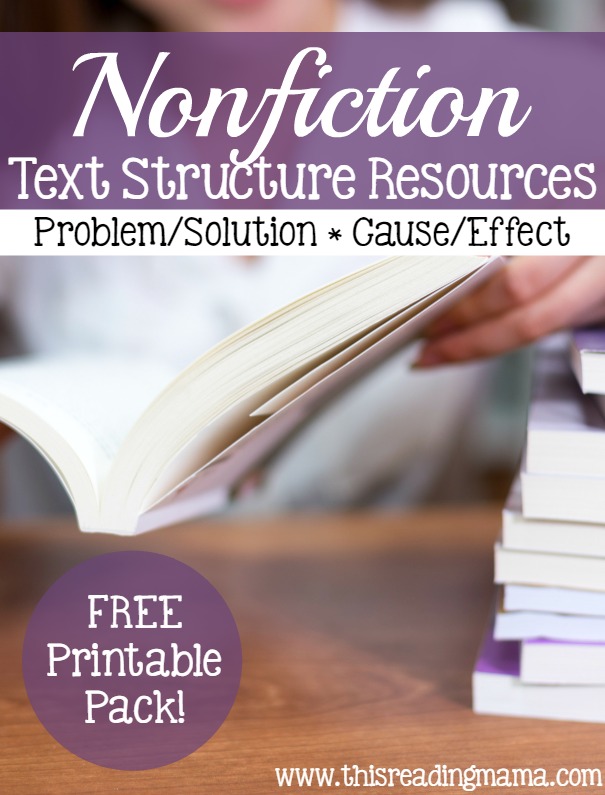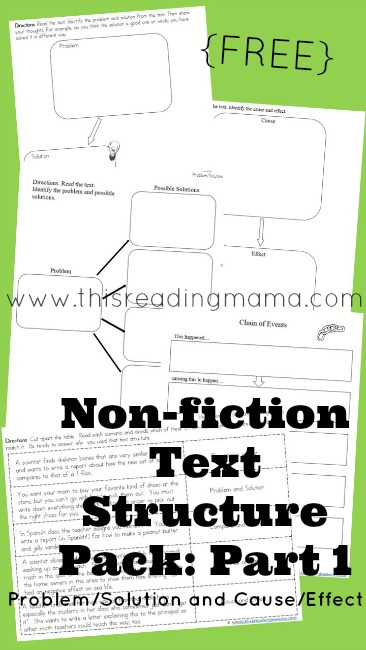
Welcome back to 5 Days of Teaching Text Structure, a five day series in conjunction with iHomeschool Network’s January Hopscotch! If you’re just joining me, feel free to visit my introduction post, and check out the other resources available on text structure.
*This post contains affiliate links. Please read my full disclosure policy for more information. Thank you!
Text Features within Non-Fiction
Today, I am exploring the topic of non-fiction. My favorite place to start exploring text with non-fiction is with text features (things like charts, photographs, captions, maps, etc.). Because authors use these visual aids to portray what is important, I want my young readers to see how they play into the organization of the text. Many times, kids skip right over these features, so I want to zero in on them for a bit. You can read a little more about text structures here or in my older blog posts here–> Part 1, Part 2, and Part 3. Emily Kissner, in her book Summarizing, Paraphrasing, and Retelling, also has a fabulous section (especially for older elementary students) on text features and text organization.
Exploring Non-Fiction Text Structure
Once I feel my reader has a grasp on text features, I set about to introduce him to text structures. While many different people have opinions on how many text structures there are, I choose to keep it simple with the students I’ve taught/am teaching. I use Scholastic’s handout on text structures to introduce it. I introduced them by going through each of the 5 text structures listed and had examples to show.
Five Examples of Non-fiction Text Structure
- Description or List– When a text describes or lists attributes about a certain topic. If you have a Gail Gibbons book laying around, she writes with this text structure a lot.
- Sequence or Time Order– When the text is written in a chronological order or special sequence. When teaching to retell fiction, we often tell kids to retell the story in order. Sequence or Time Order structure requires the same. Some examples include a recipe book, directions to playing a game, an autobiography or biography.
- Compare and Contrast– A text that compares and contrasts two subjects, such as alligators and crocodiles or Spanish and Italian origins.
- Cause & Effect*– A text that is based off a cause and effect scenario, such as listing the causes and effects of endangered animals.
- Problem & Solution*– Problem and solution should be somewhat familiar to readers who have studied fiction texts based on a problem and solution text structure although problem and solution text structures with non-fiction can be a little less obvious. Some real life examples of problem and solution include texts like advertisements in magazines for products (having difficulty teaching your child to read; tutoring program or computer program that claims to “fix” the problem; medicines, etc.).
*Cause & Effect and Problem & Solution are VERY closely related text structures and sometimes the lines aren’t so clear.
Before, During, and After Reading Activity Examples with Non-Fiction
When introducing any text structure, it is important to start with a text that is very straight forward. Many times, especially with longer texts, authors mix in multiple kinds of text structure into one text. For example, a text I have enjoyed using as I introduce problem and solution text structure is Scholastic’s Stopping a Toppling Tower. (This is a great text for 2nd through 5th grades.) Here are some things I do before, during, and after reading to help make my text structure teaching explicit for the young reader.
Before Reading:
- Check out the text features in article. Refer back to your text feature hand-out to name them.
- Using the text features alone, can you tell which non-fiction structure the author used in this article? (Sometimes, this will be obvious. At other times, it won’t.) At this point, I don’t judge the reader’s answer. I just want him to be able to make a statement and support his thoughts. This is a predicting activity and we all know that predictions do not have to be 100% correct.
- I also will ask the reader to look within the text for key words and phrases that would indicate one text structure over another. Words like, “The problem…” or “The next step…” You can find many of these key words in Scholastic’s handout on text structures .
During Reading:
- As you read, stop briefly after each section. Think about what is important information in each section. If the child is reading aloud, you might do this together a few times.
- After a section or two, I may ask probing questions, such as: What do you think some possible solutions might be to the problem?
After Reading:
- Skim or re-read the text to yourself. Highlight (most kids love to use highlighters!) the parts from each section that are important for telling someone about this article.
- In what text structure(s) would you say that this text is written? What makes you think that? Help the reader go back to his highlighted text and/or the text features. Can he support his statement?
- Think about the text structure and look at the parts that are highlighted from each section. Use those to work on summarizing the text together. Remember to emphasize that we’re going for important parts only, not small details. And we want our summary to reflect the structure of the text.
Problem and Solution AND/OR Cause and Effect?
As I’ve mentioned above, problem/solution and cause/effect structures are closely related. Sometimes authors combine the two! I always start out with straight forward texts that are clearly one or the other. Once kids have a firm grasp on each, I introduce a text that is a bit blurry between problem/solution and cause/effect. I want to see what the student thinks first. If the student is a bit confused, we talk about the hard parts. What exactly does the author say that makes him think it could be both? Talk about your thinking using examples within the text. Encourage the young reader to do the same.
Non-Fiction Text Structure Pack: Part 1
I have created a FREE pack you can download that contains a Non-Fiction text structure sort as well as several graphic organizers for Problem/Solution and Cause/Effect text structures. Click HERE or on the image above to download.
~Becky

thank you! You’ve created a wonderful resource!
You are very welcome!
Hi, Just wondering what ACARA content description this lesson would support?
I am not familiar with ACARA. I wish I could help you there.
Thank you! This is exactly what I needed. . . clarification and resources!
Yay! You are very welcome. 🙂
This is a much needed resource! I know that I am really going to be able to deliver a clear cut lesson to my 6th graders. Thank you so much for this. You are truly appreciated ?!
Yay! I love it when confusing things become a little clearer. So happy you can use it in your classroom!
This is wonderful! You mentioned that you use Stopping a Toppling Tower. What other articles/texts do you use?
I used a lot of Time for Kids articles {back when they used to be free online}. I also use various nonfiction texts. See if any of these posts/book lists help.
*https://thisreadingmama.com/nonfiction-series-books-k-5/
*https://thisreadingmama.com/teaching-text-structure-to-readers/
Thank you so much for accepting me, your resources are wonderful! I am an English teacher, intermediate level, here in Puerto Rico.
Hi, none of the Scholastic links worked for me. Just fyi.
thanks for the resources. inspiring me a lot!
This is SO helpful!! I teach third grade, but I’m adapting this to fit my students. Thanks so much for simplifying a difficult skill to teach!
You’re welcome! 🙂